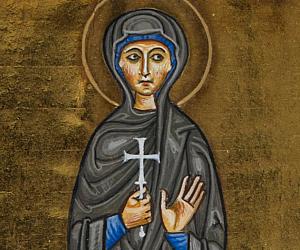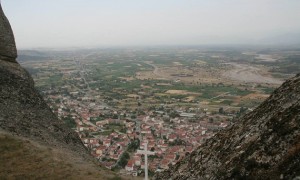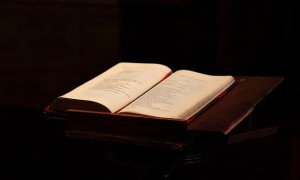Holy Tradition vs. Sola Scriptura: The Witness of the Liturgy (3)
8 August 2017The Liturgy as Pedagogical Tradition
The Liturgy preserves Apostolic, Christian teaching that predates the writing of the canonical New Testament and parallels the foundational, binding, oral traditions that originated the New Testament. This teaching communicates real, historical knowledge about the Person, the deeds, and the teachings of Jesus. What is this teaching? The teaching is the kerygma: the proclamation of Jesus as crucified and risen Lord, who was, is, and is to come; the teaching and retention of the idea of monotheism, a tenet not contradicted by the proclamation of Jesus as Lord.
Another object of teaching is about the nature of God and the anamnesis (a memorial in the sense of re-actualization) of His saving deeds contained in the berakah, the Jewish prayer of thanksgiving. This prayer will retain its basic structure in the Christian Liturgies. It becomes now a prayer to the Father of Jesus, “King of All Creation.”
But most important for our inquiry is the fact that the Liturgy probably served as the crucible for the New Testament’s formation, its trigger and preserver.
The Liturgical Tradition and the Formation of the New Testament.[20]
As the Church developed from the day of Pentecost, so did her public worship. The Church borrowed many things from Judaism: the usage of reading from the Scriptures and singing of psalms being one of many. This carryover became the Synaxis (Gr. meeting). The Synaxis became fixed in Christian worship in the decade after the Passion.[21]
The Christian Synaxis had its own unchanging outline everywhere. It is as follows:
(1) Opening greeting by the officiant, and the reply of the Church;
(2) Lesson;
(3) Psalmody;
(4) Lesson (or Lessons, separated by psalmody);
(5) Dismissal of those who did not belong to the Church;
(6) Prayers;
(7) Dismissal of the Church.[22]
The Lessons, or readings, were at first from the Old Testament, as this was the immediate Jewish custom that the first generations of Christians gave to the Church. It is within this context of worship that the words and deeds of Jesus were first remembered.
First, quite informally, the Apostles or the surviving witnesses would relate the words of Jesus, his sayings, his actions, or the main events in the life of the Savior. This possibly took place after the reading from the Hebrew Scriptures, to which the given pre-Gospel narrative would be related in some way.
The faithful remembered these words with varied degrees of clarity. Other hearers would take notes of these extemporaneous, kerygmatic narratives, centered on the words and deeds of Christ. As the Apostles and the first Christian generation started to pass on, the attempts to preserve the Memories of the Apostles became more and more formal, culminating in the writing of the canonical New Testament.
Clues to this scenario can be found in the New Testament itself. The Gospel according to St. Mark, for example, preserves the simplicity and the directness of something that was primarily proclaimed orally, rather than in a written form. We can also find another clue in the existence of hymns in the New Testament, which were later adapted to support points of doctrine. We can see those hymns in the first chapter of the Gospel according to St. John, for example, or in the letter of St. Paul to the Philippians 2:5-11. These hymns (and there are others) were more than likely composed by now unknown believers and then sung in the early Christian Liturgies. They were significant enough in doctrinal content to be included in the New Testament.
Thus, the Liturgy had a direct impact on the formation of the New Testament. First, the Eucharist, the Christian chabûrah, preserved the knowledge, nay, the experience of the risen Lord as Messiah and Savior sent by the Father; now it fostered the thirst of the community for more knowledge about the Messiah.
The Liturgy, then, attracted the foundational, binding, and oral traditions that were later collated and redacted into the canonical Gospels. As this relationship developed, these traditions influenced the evolution of the Liturgy more and more. These traditions gave the Liturgy new modes of expression, prayer, and song.
The pre-Gospel oral traditions received from the Liturgy their legitimacy, format, and focus. Once this mutual relationship started, it never stopped. The Christian Scriptures received their constitution from the independent, foundational, and binding liturgical tradition. They formed a continuum, a unity. They both disclose, in exactly the same way, the God revealed in Jesus Christ. Each of the liturgical and the Gospel traditions only becomes intelligible with the help of the other. Together they form the rule of faith, the Holy Tradition of the Church, as Orthodox Christianity understands it.
Holy Tradition Defined
We can now attempt to compose a definition of Holy Tradition:
Holy Tradition is the totality of God’s self-disclosure in Jesus Christ, granted through the Lord Jesus Christ Himself and preserved by the Holy Spirit for the benefit of the worshipping, liturgizing Church, which is given for the purpose of revealing to that very same Church God’s hidden designs regarding the salvation and sanctification of the human race.
The above definition enjoys the following advantages:
• It sets the origin of Holy Tradition in God Himself. We have seen that the Old Testament, the holy traditions that became the New Testament, and the Liturgy all originate in the Person of the Logos, be that in His eternal existence with the Father, or during His earthly ministry;
• It is set in God’s disclosure in Jesus Christ; it is Christian Holy Tradition;
• It is preserved by the Holy Spirit, not only in its outer form, but also in its inner interpretation, be it of the Bible, or of the Divine Liturgy;
• It is given to the Church, and to that Church that maintains the Apostolic rule of worship; it is given to a Church that offers the Divine Liturgy. Other Christian bodies which do not liturgize lack the Holy Tradition. It is also within the liturgical context where the Word (to quote Luther) is rightly preached and the sacraments rightly administered. Finally, this aspect of the definition sets forth the constitution of the Church as the Body of Christ, bound by the mysteries of God’s revelation, the Eucharist, and the Apostolic Preaching. It sets the Church of Jesus Christ apart from rival claimants;
• It is given for the salvation of the Church, which is granted within the Liturgical Church. Those who are in the Church are granted the full knowledge and benefit of God’s revelation in Jesus Christ for the sanctification and salvation of their souls.
Holy Tradition as Doctrine
Dr. Jaroslav Pelikan defined doctrine as that which is believed, taught, and confessed.[23] For this definition to be complete, from the Orthodox Christian perspective, we need to again recall the ancient standard of belief: Lex orandi, lex credendi.
The law (rule, or standard) of prayer is the law (rule, or standard) of belief. How and when did they pray as a Church? They did so in the Liturgy.
What is believed is then taught. What is taught is then confessed by the Church. Where do we find this confession? We find it primarily in the Divine Liturgy, where the primitive confession first took its shape and found its earliest expression. We find it in the New Testament, the first inspired, written confession of the Church. Finally, we find it in the more formal declarations of faith that we call creeds.
The Orthodox approach to doctrine is holistic. By maintaining the liturgical context within which Christian revelation first came to be, Orthodox doctrine is more organic, more attuned, to the entire continuum of Christian revelation.24 Because it encompasses the rule of prayer as the rule of belief, and the sources or instruments of Revelation within itself, together with proper exegesis and interpretation of the Bible, Holy Tradition is the source of doctrine for the Orthodox Church.
What, then, of Sola Scriptura?
The Protestant failure to establish, reform, or restore the ancient standard of Christian worship stands as a symbol of the failure of Sola Scriptura. The Bible alone was not sufficient for the Reformers to reestablish the ancient understanding and shape of the Liturgy and the Eucharist. They only succeeded on rehashing the medieval Latin rite in accordance to their notion of Scriptural warrant.
Conventional wisdom suggests that the Protestant preference for Sola Scriptura preceded and justified the rejection of anything smacking of Catholic forms of worship. This is especially true of Reformed Protestantism in its multiple manifestations. Perhaps we have placed the cart before the horse here.
Protestantism’s birth was due, in part, to a reaction to medieval abuses that have crept into the Latin rite and deformed it, obscuring its underlying, original shape. The tenet of Sola Scriptura is the only logical remnant of Apostolic teaching after the rejection of the historical Liturgy in all of its forms. Once Reformed Protestantism rejected the revelational and salvific value of the Divine Liturgy, it became necessary to hold on to, and further develop, the notion of Sola Scriptura. There was no other alternative.
Conclusion
Sympathetic as we might be to the Protestant quandary, and to its underlying causes, we need to understand the inadequacy of the Bible being the only and sufficient source for Christian faith and morals and the sole container of Divine Revelation, especially in the light of the evidence presented above. The Protestant believer needs to face the Orthodox challenge to Sola Scriptura, a challenge which forms the basis for our conclusion:
The existence and divine origin of the Liturgy or Eucharist, specifically, of its shape, and of its role in creating, forging the belief, teaching, and the confession of Christian doctrine obviates the need for the Protestant tenet of Sola Scriptura. It is not Scripture Alone, but Holy Tradition, in its all encompassing nature, that forms the basis of Christian doctrine. Protestantism has failed in its mission of reforming the Church to its original intent through its ignorance and failure to understand the Eucharistic nature of the Church and the Liturgical context of Christian Revelation. This failure is the fatal flaw of Protestantism.
This article was originally published in The Christian Activist Vol. 10 and is posted here with permission.
20. The following scenario is based upon what we know of the development of the pre-Gospel oral traditions as determined by form criticism.
21. Dix, 36.
22. Dix, 38. The transition to the Eucharist proper developed later.
23. Pelikan, Jaroslav. The Christian Tradition: A History of the Development of Doctrine. Vol. 1: The Emergence of the Catholic Tradition, p.3.
24. Orthodoxy avoids drawing any doctrine solely from one individual source, be that the Bible alone, or the magisterium as the regula próxima fidei.
Works Cited
Beckwith, R.T. The Jewish Background to Christian Worship. The Study of Liturgy. Ed. Cheslyn Jones et al. New York: Oxford University Press, 1978.
Brown, Raymond E., et al. The Jerome Biblical Commentary. Englewood Cliffs, New Jersey: Prentice Hall, 1968.
Bruce, F.F. The Canon of Scripture. Downers Grove, Illinois: InterVarsity Press, 1988.
Calvin, John. Ed. John T. McNeill. “How far does the Fourth Commandment go beyond external regulation?” Institutes of the Christian Religion. Philadelphia: The Westminster Press, 1960. 2 vols.
Dix, Gregory. The Shape of the Liturgy. London: Dacre Press, 1945.
Jones, C.P.M. The New Testament. The Study of Liturgy. Ed. Cheslyn Jones et al. New York: Oxford University Press, 1978.
Jurgens, William A. The Faith of the Early Fathers. Collegeville, Minnesota: The Liturgical Press, 1970. 3 vols.
Pelikan, Jaroslav. The Christian Tradition: A History of the Development of Doctrine. Vol.1. The Emergence of the Catholic Tradition. Chicago and London: The University of Chicago Press, 1971.
Staniforth, Maxwell, and Andrew Louth. “The Epistle to the Smyrnaeans.” Early Christian Writings: The Apostolic Fathers. Great Britain: Penguin Books, 1968, 1987.












